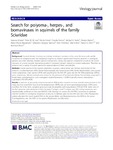Search for polyoma-, herpes-, and bornaviruses in squirrels of the family Sciuridae
Schulze, Vanessa
Lurz, Peter W. W.
Ferrari, Nicola
Romeo, Claudia
Steele, Michael A.
Marino, Shealyn
Mazzamuto, Maria Vittoria
Calvignac-Spencer, Sébastien
Schlottau, Kore
Beer, Martin
Ulrich, Rainer G.
Ehlers, Bernhard
Background
Squirrels (family Sciuridae) are globally distributed members of the order Rodentia with wildlife occurrence in indigenous and non-indigenous regions (as invasive species) and frequent presence in zoological gardens and other holdings. Multiple species introductions, strong inter-species competition as well as the recent discovery of a novel zoonotic bornavirus resulted in increased research interest on squirrel pathogens. Therefore we aimed to test a variety of squirrel species for representatives of three virus families.
Methods
Several species of the squirrel subfamilies Sciurinae, Callosciurinae and Xerinae were tested for the presence of polyomaviruses (PyVs; family Polyomaviridae) and herpesviruses (HVs; family Herpesviridae), using generic nested polymerase chain reaction (PCR) with specificity for the PyV VP1 gene and the HV DNA polymerase (DPOL) gene, respectively. Selected animals were tested for the presence of bornaviruses (family Bornaviridae), using both a broad-range orthobornavirus- and a variegated squirrel bornavirus 1 (VSBV-1)-specific reverse transcription-quantitative PCR (RT-qPCR).
Results
In addition to previously detected bornavirus RNA-positive squirrels no more animals tested positive in this study, but four novel PyVs, four novel betaherpesviruses (BHVs) and six novel gammaherpesviruses (GHVs) were identified. For three PyVs, complete genomes could be amplified with long-distance PCR (LD-PCR). Splice sites of the PyV genomes were predicted in silico for large T antigen, small T antigen, and VP2 coding sequences, and experimentally confirmed in Vero and NIH/3T3 cells. Attempts to extend the HV DPOL sequences in upstream direction resulted in contiguous sequences of around 3.3 kilobase pairs for one BHV and two GHVs. Phylogenetic analysis allocated the novel squirrel PyVs to the genera Alpha- and Betapolyomavirus, the BHVs to the genus Muromegalovirus, and the GHVs to the genera Rhadinovirus and Macavirus.
Conclusions
This is the first report on molecular identification and sequence characterization of PyVs and HVs and the detection of bornavirus coinfections with PyVs or HVs in two squirrel species. Multiple detection of PyVs and HVs in certain squirrel species exclusively indicate their potential host association to a single squirrel species. The novel PyVs and HVs might serve for a better understanding of virus evolution in invading host species in the future.
Files in this item

